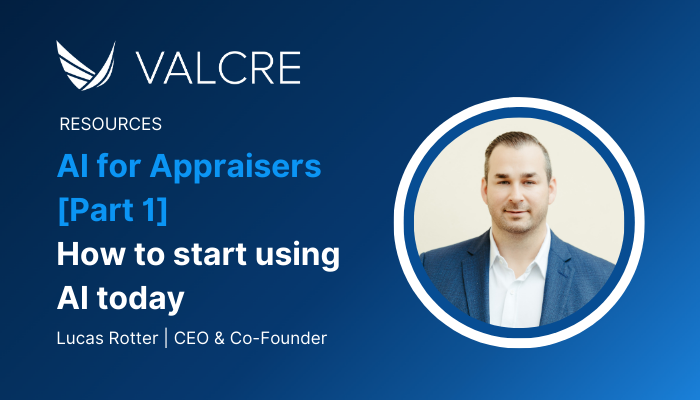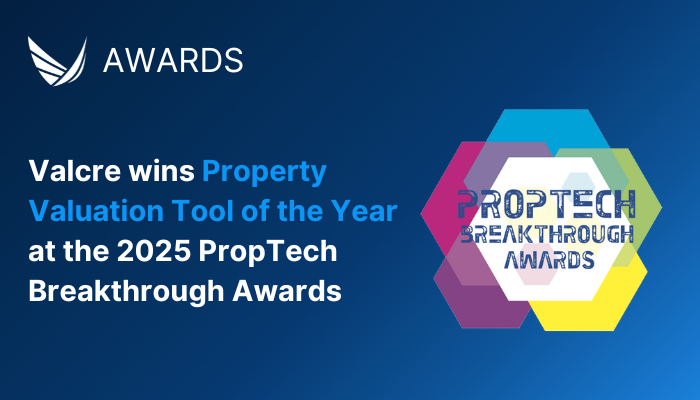
AI is no longer a buzzword—it’s a business reality. For appraisers, intelligent tools like automation, machine learning, and predictive analytics are reshaping how reports are created and delivered. The pressure is on to work faster, smarter, and with greater accuracy. But for many firms, the biggest question remains: where do we start?
I recently spoke with a group of leading appraisers about what’s ahead for 2025. One thing stood out—AI dominated the conversation. From automation to predictive analytics, it’s not just about speeding things up. It’s about helping appraisers work smarter, make more informed decisions, and meet growing client expectations.
To help, we’ve put together this blog series as a practical guide to understand the real-world uses of AI for appraisal businesses and the best steps to take to get ready to actually implement AI technologies. You’ll discover:
- How appraisers can actually use AI tools – this article!
- How to evaluate AI vendors – READ NOW
- How to build a solid foundational database to support AI *Coming soon*
- How to manage change across your team to ensure long-term success *Coming soon*
Enjoy.
How can appraisers actually use AI tools?
There are two main areas where AI-based tools can be used by appraisal firms:
- Generalist tools to manage day-to-day business operations
- Specific tools designed to manage the appraisal workflow
Let’s take a look at each.
1. General business AI tools
The use cases for AI across your business can vary widely but generally result in the same benefit for your team – reducing time spent on manual, repetitive tasks so that they have more time to spend on their actual role, appraising.
Some of the most common (and impactful) examples include:
- Appointment scheduling
- Task and project management
- Sending and processing invoices
- Automating email responses
- Creating content including marketing copy and social media posts
2. AI solutions specifically for appraisers
The opportunities for AI to help appraisal businesses specifically within the appraisal workflow are exciting and have the power to be transformative.
At Valcre, we’re most excited about the potential of AI as it pertains to two main themes:
- Efficiency – How can we make appraisers even more efficient by streamlining workflows with AI enhancements? Can we remove the taxing, menial, day-to-day “to do’s” that fall to appraisers today?
- Accuracy – How can we empower appraisers to make better informed conclusions with AI models that deliver accurate valuation results at all steps of the appraisal process?
Let’s now break each of these down into the specific capabilities coming online where appraisers stand to benefit the most.
Key AI use cases for CRE appraisers
Comparable recommendations
Finding the best comparables for your subject requires a lot of searching but is necessary for an accurate valuation. With an AI-powered recommendation engine, all of the comps in your database can be scored for applicability to your subject based on a variety of attributes including distance, age, and size, and the most applicable comps can be suggested straight away.
A virtuous loop will form – as appraisers select comps, the AI model will learn what’s working and improve its recommendations over time.
Document extractions
Appraisers see documents in all shapes and sizes, and of varying levels of quality. AI removes the need for appraisers to go through the time consuming effort of copying and pasting, and manually entering data into reports. Instead, appraisers will be able to drag and drop data from different documents and have it auto-match to the correct fields in their database.
Report writing
While appraisal software such as Valcre already helps streamline narrative writing in reports, there is a great opportunity to take it further with AI.
AI models are exceptional tools for writing large amounts of narrative, but appraisers have to be careful about making sure what they write is accurate. Sometimes AI can write something that looks accurate at a glance, but can contain fake or inaccurate data (“hallucinations”).
The best way to prevent AI inaccuracies is by starting with highly accurate data that’s already been validated, and pairing it with clear guidelines on how that data should be used depending on the narrative.
The model will learn from patterns and improve going forward, increasing efficiency and leveling up the overall experience for users.
Capturing data insights
As appraisers know, the end-to-end valuation process has a large number of different touch points requiring multiple data sources and the review of different datasets.
AI presents a significant opportunity to uncover data in a way that is much more meaningful for appraisers, and incorporate unique insights into their reports – from both their own databases as well as third-party sources via integrations.
While appraisers themselves have the best understanding of market data and trends, large language models (LLMs) and AI models have the potential to quickly surface, for example, what insights can be gleaned from charts and other data worth paying attention to, empowering decision making.
Report reviews
In a major win for appraisers, AI-powered tools will be able to automatically review reports for grammatical errors and typos. They can also examine the data you’re using and identify any questionable numbers or outliers, and then alert you to go back and look at it.
Bid optimization and business intelligence
Finally, AI will enable users to capture insights on their assignments, clients, and win/loss bid ratios, and generate reports for regular business reviews so that appraisal businesses can run their teams more efficiently and successfully.
As with any new technology, AI will have its limitations which appraisers should be aware of. For example, AI isn’t going to generate a perfect report or comp set out of the box. Appraisers will need to use their appraisal expertise and add their unique knowledge to finesse the output. That said, the improved output, both in quality and volume, in addition to the time saved, means that these AI use cases cannot and should not be ignored by appraisal businesses.
How appraisal businesses can get started with AI
As these transformative opportunities rapidly emerge, it’s crucial for appraisal businesses to position themselves to take full advantage. There are two key areas appraisers should focus on when preparing for AI adoption:
- Evaluating AI vendors – Not all AI tools are created equal. You’ll want partners who understand the appraisal workflow, prioritize data privacy, and let you control how AI is applied.
- Establishing a solid data foundation – Your internal database is the backbone of any AI capability. Without clean, searchable, well-structured, and centralized data, even the most advanced tools won’t deliver value.
What’s next?
Over this blog series, we’ll cover:
- How to evaluate AI vendors and avoid common pitfalls – READ NOW
- How to prepare your data and systems to support AI *Coming soon*
- How to manage change across your team and drive long-term adoption *Coming soon*
Valcre is here to help and we’re already working with appraisal teams across the country to get their databases up and running so that they can leverage the benefits of AI and other technologies to enhance their report writing capabilities. If you’d like to talk to our team, you can schedule a demo here.


![AI for Appraisers [Part 4]: Managing change for a successful AI rollout](https://www.valcre.com/wp-content/uploads/Blog-featured-image-–-AI-Content-Series-May-2025-8.png)